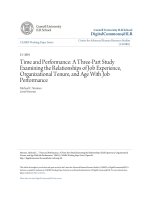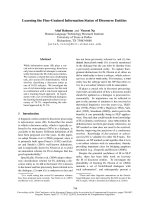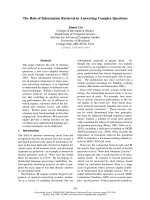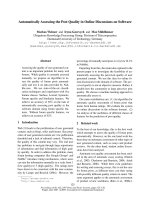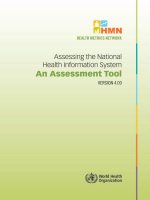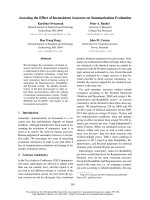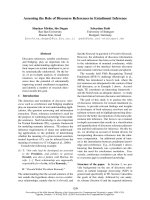Assessing the relationships among information technology flexibility, IT-business strategic alignment, and information technology effectiveness An investigation of business intelligence implementation
Bạn đang xem bản rút gọn của tài liệu. Xem và tải ngay bản đầy đủ của tài liệu tại đây (3.6 MB, 287 trang )
ASSESSING THE RELATIONSHIPS AMONG INFORMATION TECHNOLOGY
FLEXIBILITY, IT-BUSINESS STRATEGIC ALIGNMENT, AND
INFORMATION TECHNOLOGY EFFECTIVENESS: AN INVESTIGATION OF
BUSINESS INTELLIGENCE IMPLEMENTATION
by
Jordan Bani
LAWRENCE NESS, PhD, Faculty Mentor and Chair
KATHLEEN HARGISS, PhD, Committee Member
MARY KARLENE SANBORN, EdD, Committee Member
William A. Reed, PhD, Acting Dean, School of Business and Technology
A Dissertation Presented in Partial Fulfillment
Of the Requirements for the Degree
Doctor of Philosophy
Capella University
March 2011
UMI Number: 3449293
All rights reserved
INFORMATION TO
ALL USERS
The quality of this reproduction is dependent upon the quality of the copy submitted.
In the unlikely event that the author did not send a complete manuscript
and there are missing pages, these will be noted. Also, if material had to be removed,
a note will indicate the deletion.
UMI 3449293
Copyright 2
011
by ProQuest LLC.
All rights reserved. This edition of the work is protected against
unauthorized copying under Title 17, United States Code.
ProQuest LLC
789 East Eisenhower Parkway
P.O. Box 1346
Ann Arbor, MI 48106-1346
© Jordan Bani, 2009
Abstract
Many researchers called for research on the relationship among IT-business strategic
alignment (SA), IT flexibility (ITF), and IT effectiveness (ITE) to be extended to broader
business environments in private and public sectors. The goal of this study was to fill the
gap and address a limitation in previous scholarly research study (Ness, 2005) in the IT
executive’s perception of SA, ITF, and ITE via the implementation of business
intelligence (BI) applications within the public school districts. The role of BI solution in
business is becoming a focal point because BI can be considered as a business driven
technologies that delivers the right information in the right way to the right people in the
most effective way for effective strategic and operational business decisions. In pursuit of
the optimal IT effectiveness, the study findings provided empirical evidence to support
the study hypothesis that IT-business strategic alignment has a stronger positive
correlation with school districts’ IT effectiveness than IT flexibility; therefore, tighter IT-
business strategic alignment and responsiveness were found critical and valuable for
school districts’ IT effectiveness and business productivity. The research findings
depicted that ITF has no overall impact on ITE; but, ITE in school districts is ultimately
decided based on their IT-business strategic alignment. In addition, it can be concluded
that sufficient ITF could be considered as an enabler and a prerequisite component for an
advanced maturity level of strategic alignment in school districts. Indeed, more research
is needed to assess which construct(s) (ITF, SA, and/or ITFxSA) affect organizations’ IT
effectiveness and productivity. In a future study, the researcher recommends conducting a
cross-industry (private and public sectors) comparison of these constructs via BI systems
implementation and usage from both IT and business executives’ perspective.
iii
Dedication
This dissertation study is dedicated to my parents and my wife for their
continuous support and encouragement to complete this research. I would like to dedicate
this research to my sons and my daughters for their help and encouragement during this
study, who tolerated my countless hours of endless research. Finally, I would like to
dedicate this study to my oldest brother Dr. Bani, who has been a life-long friend,
mentor, and inspiration.
iv
Acknowledgments
I would like to acknowledge and thank my distinguished mentor, Dr. Ness, and
my committee members, Dr. Hargiss and Dr. Sanborn, for their guidance,
encouragement, and speedy and valuable feedback throughout the dissertation
milestones; it has been my distinct honor to work with and to be guided by this
committee through my dissertation journey. I would like to thank all the participants of
the study survey for their time and willingness to take the survey questionnaire, which
made this study findings possible and worthy to both the practitioner and the scholar.
v
Table of Contents
Acknowledgments iv
List of Tables viii
List of Figures ix
CHAPTER 1. INTRODUCTION 1
Introduction to the Problem 3
Background of the Study 7
Statement of the Problem 10
Purpose of the Study 12
Rationale 14
Research Questions 15
Significance of the Study 17
Definition of Terms 18
Assumptions and Limitations 23
Nature of the Study 24
Organization of the Remainder of the Study 24
CHAPTER 2. LITERATURE REVIEW 27
Introduction 27
Information Technology Flexibility (ITF) 29
IT-Business Strategic Alignment (SA) 41
Information Technology Effectiveness (ITE) 60
Business Intelligence (BI) 65
CHAPTER 3. METHODOLOGY 75
vi
Purpose of the Study 75
Restatement of the Problem 76
Research Questions 78
Statement of Hypotheses 79
Extended Conceptual Framework Model 81
Operational Definition of Variables 82
Research Design 85
Sample 86
Setting 88
Instrumentation/Measures 89
Data Collection 90
Data Analysis 91
Validity and Reliability 94
Ethical Considerations 95
CHAPTER 4. DATA COLLECTION AND ANALYSIS RESULTS 96
Introduction 96
Research Study Survey 97
Research Study Results 99
Data Analysis for Research Questions 124
CHAPTER 5. DISCUSSION, IMPLICATIONS, RECOMMENDATIONS 136
Overview 136
Discussion 140
Conclusions 145
vii
Limitations and Recommendations 147
REFERENCES 149
APPENDIX A. CONSTRUCT ELEMENT TABLE 161
APPENDIX B. IT EXECUTIVES SURVEY QUESTIONNAIRE 166
APPENDIX C. LETTER OF INVITATION TO PARTICIPATE 181
APPENDIX D. DESCRIPTIVE STATISTICS FREQUENCIES 184
APPENDIX E. CORRELATION AND REGRESSION ANALYSIS 233
viii
List of Tables
Table 1. Scale: Independent and Dependent Variables Cronbach's Alpha 101
Table 2. ITF-Connectivity (ITF1) Frequency Distribution 103
Table 3. ITF-Compatibility (ITF2) Frequency Distribution 104
Table 4. ITF-Modularity (ITF3) Frequency Distribution 105
Table 5. IT Personnel Competency (ITF4) Frequency Distribution 106
Table 6. SA-Communications (SA1) Frequency Distribution 108
Table 7. SA-Value (SA2) Frequency Distribution 109
Table 8. SA-Governance (SA3) Frequency Distribution 109
Table 9. SA-Partnership (SA4) Frequency Distribution 110
Table 10. SA - Scope and Architecture (SA5) Frequency Distribution 112
Table 11. SA-Skills (SA6) Frequency Distribution 113
Table 12. ITE-Quality of service (ITE1) Frequency Distribution 115
Table 13. ITE-Users’ Satisfaction (ITE2) Frequency Distribution 116
Table 14. ITE-Helpfulness of IT Staff to Users (ITE3) Frequency Distribution 117
Table 15. Chi-Square Crosstabs Analysis (n = 174) 119
Table 16. Bivariate Correlations - Analysis (n = 174) 120
Table 17. Partial Correlations - Analysis (n = 157) 124
Table 18. Inter-Scale Correlation Analysis Results (n = 157) 125
Table 19. Stepwise Multiple Regression Model Summary (n = 157) 130
Table 20. Stepwise Multiple Regression Model – Coefficients (n = 157) 131
ix
List of Figures
Figure 1. Conceptual framework model 12
Figure 2. Framework depicting the relationship between ITF and ITE (Ness, 2005). 13
Figure 3. Extended conceptual framework model 81
Figure 4. The revised conceptual framework model 133
Figure 5. The simplified framework model 134
1
CHAPTER 1. INTRODUCTION
In the ever-changing and complex business environment caused by government
regulations, consumer demands, globalization, and markets and competitions, enterprises
in the public and private sectors are facing pressures to respond proactively to these
environmental factors rapidly and be innovative and effective tactically and strategically
in order to survive and prosper. Therefore, organizations are required to be agile, and
organizations’ executives are required to have the right information at the right time to
make strategic and tactical decisions, which may require a considerable amount of time to
process data and information to produce the relevant knowledge to make better decisions
by using business intelligence computerized support applications. Business intelligence
(BI) can improve decision making and enhance an organization’s strategic position to
effectively respond to the business environment pressures and even take advantage of
opportunities to excel, because one of the main objectives of BI is to close the gap of
alignments to strategically achieve an organization’s mission, objectives, and goals
(Turban, Sharda, Aronson, & King, 2008). Business intelligence is a powerful tool to
assist in business process improvement initiatives; furthermore, BI solutions help
companies achieve real benefit by providing data and analytics to analyze and control
business processes at both the business strategic and operational levels.
Business intelligence (BI) continues to top the list of technological priorities since
2005, based on the 2008 Gartner Group CIO survey (Viaene, 2008). The demand for BI
data continues to increase, and there is a great pressure and need to develop and
implement new technologies to improve existing processes in order to boost effectiveness
2
and add business value by implementing BI applications to ensure that the right people
get the right information at the right time in order to make informed business decisions.
There are major changes in how IT executives use IT to support education and business
within the public school districts. School districts are becoming more dependent on IT
and are becoming more Web and Internet literate because they are using Web-based
enterprise information systems (EIS), enterprise BI applications, and analytical
computerized tools to support their work and to deliver strategic and high business values
of education and business. Business intelligence (BI) is an umbrella term that
encompasses many components, such as architecture, databases, enterprise information
systems (EIS), Web-based analytical tools and applications, and enterprise performance
management (EPM); all these components are integrated into a business suite application
under a conceptual BI framework (Turban et al., 2008). Therefore, implementing and
deploying BI applications within school districts can enable IT and business executives to
make better decisions and to plan strategically because they have access to more accurate
and timely information. Furthermore, IT efficiency and effectiveness can arise from
school districts’ possession of BI applications.
This study focused on assessing the relationships among IT flexibility, IT-
business strategic alignment, and IT effectiveness via business intelligence (BI)
enterprise information system implementation within the public school districts. There is
a clear distinction between IT efficiency and IT effectiveness according to Tallon,
Kraemer, and Gurbaxani (2000); IT efficiency achieves as a result of using IT automation
and standardization to improve performance and productivity and to reduce operation
costs. Information technology effectiveness comes as a result of using IT flexibility and
3
IT-business strategic alignment to foster greater responsiveness and flexibility to the
dynamic business needs, and it enables and drives the organization’s business strategy.
McGaughey and Gunasekaran (2007) asserted that enterprise systems are designed to
deliver operational efficiency and effectiveness through integrating, streamlining,
redesigning, and improving business processes reengineering (BPR).
Introduction to the Problem
Information technology (IT) has become the essential infrastructure of any
enterprise, and the enabler of the business process (Gallo, 2010; Pantazi & Georgopoulos,
2006; Silvius, de Waal, & Smit, 2009). The advancement of business intelligence (BI),
Web-enabled decision support systems (WDSS), and Web-based and Web services has
revolutionized the business intelligence (BI) to support the dynamic business
environment and enterprise agility (Zhao, Tanniru, & Zhang, 2007); IT has been
embraced as the new standard for enabling an enterprise to interact with its stakeholders
to fulfill its business strategy.
Organizations are turning to IT for assistance because IT and BI are the
foundations that enable their business success (Hosseini & Mazinani, 2006; Turban et al.,
2008); most organizations in private and public sectors are deeply dependent on
information technologies (Ward & Peppard, 2005). Therefore, Shupe and Behling (2006)
argued that budgeting for IT should be treated as an investment. Large investments,
which may be considered capital investments, are being made in implementing and
deploying Web and knowledge-based enterprise systems and BI applications in
organizations. It is estimated that more than 15 to 30% of companies’ budgets are
4
allocated to IT, and a good portion for EIS and BI applications. The public school
districts spend a large portion of their annual budget on IT; it is estimated that around 13
to 18% of school district’s budgets are allocated to IT. These large investments in IT
make it necessary to assess how the primary variables correlate and contribute to IT
effectiveness. To justify an IT investment, top business and IT executives need to
understand the potential benefits resulting from the investment in EIS (Banker, Chang, &
Kao, 2002) and business intelligence applications. The benefits of ES and BI applications
can range from operational improvements, such as enhancing performance and reducing
costs, to strategic impacts, such as enabling and supporting the business strategy and
integrating the stakeholders (Volkoff, Strong, & Elmes, 2005). Information technology
function, especially the business intelligence (BI), is changing into a strategic partner and
enabler because of its essential role in the school district.
Information technology effectiveness and efficiency that enables and supports
business strategy and process is a key factor for a successful organization in a dynamic
environment (Pantazi & Georgopoulos, 2006; Silvius et al., 2009). Chief information
officers (CIOs) and IT decision makers at the school district are faced with a huge
pressure to provide and drive efficiency, innovation, and effectiveness within their
organizations. The effectiveness of IT in a school district goes beyond just software and
hardware; it is IT-business strategic alignment that is deemed critical in the mind of IT
executives (Luftman, Kempaiah, & Nash, 2006; Silvius et al., 2009). BI deployment
helps improve the alignment of IT and business by detailing the relationship between IT
and business. In addition, a natural result of ES and BI applications implementation is
increased efficiency and productivity (Silvius et al., 2009). Turban et al. (2008) stated
5
that via information provided by BI applications, school districts can enhance their
competencies and ability to innovative, improve decision making and strategic planning,
improve customer responsiveness, and improve business performance.
Top management and IT executives in public and private enterprises are aware
that investment in a successful deployment of BI applications can affect the efficiency
and effectiveness of organizational performance (Alshawaf & Khalil, 2008; Drucker,
1998; Hosseini & Mazinani, 2006; Luftman, 2005; Ness, 2005; Ward & Peppard, 2005).
Information technology effectiveness and efficiency can enable and drive innovation and
add productivity and business value. Huq and Martin (2006) concluded that market
pressure is forcing enterprises to implement enterprise system(s) and BI applications for
achieving efficiency and effectiveness. Byrd and Davidson (2006) concluded that IT
effectiveness increases organization performance and productivity. Therefore, it is critical
to understand that IT effectiveness and efficiency can lead to better organization
performance and support and enable its strategic business needs. Ranganathan and Brown
(2006) asserted that organizations are adopting BI to have flexible IT architecture which
will enable real time visibility to information organization wide. Business intelligence
(BI) provides visual presentation of critical data and information which allows executives
to vie, explore, and make decisions. Thus, improving IT efficiency and effectiveness can
enable and drive innovation and add business value in an enterprise.
The attainment of IT efficiency and effectiveness should be the focus of a
business’s attention and strategic orientation; the goal of IT investment is to complement
company strategy and enable the company to gain superior business performance and to
sustain competitive advantage (Hosseini & Mazinani, 2006; Luftman, 2005; Rajendran &
6
Vivekanandan, 2008). Achieving and sustaining IT-business strategic alignment,
flexibility, and effectiveness have been long-standing goals that many IT and business
leaders are continually looking and striving to accomplish in their organizations
(Luftman, 2005; Luftman & Kempaiah, 2007; Ness, 2005; Ward & Peppard, 2005).
Studies have shown that IT-business strategic alignment contributes to higher levels of
organizational performance and perceived business value from IT (Chen & Kamara,
2008; Luftman, 2005; Luftman & Kempaiah, 2007; Rajendran & Vivekanandan, 2008).
Thus, there is a positive relationship between IT-business strategic alignment (SA) and IT
effectiveness (Luftman, 2005; Tallon & Kraemer, 2003; Pantazi & Georgopoulos, 2006).
Information technologies are changing the nature of education throughout the
world. Business intelligence (BI) and enterprise system (ES) play a critical role in how
the school districts teach, and they support and enable instructional and administrative
programs. School districts strive to use BI applications in an increasingly seamless
manner to empower administrative and instructional programs, coordinate the flow of
information throughout the school districts, integrate IT with the outside stakeholders,
and improve home and school communication (Delbaere & Ferreira, 2007). However,
federal and state financial resources are diminishing because of the current economic
turmoil; therefore, school districts are forced to scale back funding of IT projects and do
more with less (Pierce, 2005) and IT budgets continue to be tighten, yet the school
districts are required to provide effective and efficient services and meet the strategic
business needs; and business services demand technology innovation. A well executed
deployment of BI systems can enhance business performance to school districts.
7
According to the U.S. Department of Education’s National Center for Education
Statistics (2006), nationwide there are 14,166 school districts, 97,382 public schools,
49,894,627 students, and 3,191,539 teachers across the nation. The public K-12 school
districts are adopting and deploying BI and ES packages to support the instructional and
business needs; the main objective is to achieve higher efficiency and cost and time
savings for a school district through process standardization, simplification and
automation, governance, and tighter integration across the organization and stakeholders.
In addition, businesses that are utilizing enterprise systems are better positioned for
innovation, flexibility, and change (Delbaere & Ferreira, 2007). Information technology
(IT), especially enterprise system (ES) and BI applications, has played a core and vital
role in the services provided by the school districts. However, no empirical study has
evaluated the impact of IT, especially BI applications, on public school districts’
effectiveness, flexibility, and alignment. The need to assess the effect of BI applications
adoption and deployment on a district’s IT flexibility, IT-business strategic alignment,
and IT effectiveness motivates this study.
Background of the Study
The public sector, including public school districts and universities, is generally
criticized for lagging behind the private business sector in the adoption of new
information technologies (Seethamraju, 2007). Public sector officials are often depicted
as being less innovative in IT effectiveness because of the bureaucracy and formal
operational procedures environment (Thong, Yap, & Kin-Lee, 2000); officials in the
public sector and districts have to follow fixed procedures because of formal regulations.
8
According to Pierce (2005), chief information officers (CIOs), chief technology officers
(CTOs), and information technology (IT) directors in school districts are faced with
challenges which create difficult balancing acts as they strive to meet the diverse needs
and goals of administrators, teachers, students, parents, and other stakeholders. CIOs and
IT decision makers are faced with a huge pressure to provide and drive efficiency,
innovation, and effectiveness within their organizations and school districts.
School districts are investing in information technologies at an increasing rate
implementing and deploying information systems to support their instructional and
business strategies in their efforts to manage and plan strategically (Wang & Zionts,
1997). A school district strives to implement a comprehensive enterprise BI application
for managing its business and instructional functions (Pierce, 2005), because BI
applications tie together the school district’s back-office enterprise through a single
integrated enterprise system. An enterprise BI application that records, processes,
governances and monitors, and reports information and knowledge management within
the school district helps the district facilitate and sustain business and offers a
competitive advantage (Hoffer, George, & Valacich, 2008), by providing efficient and
effective services and information and knowledge management to teachers, business
users, decision makers, parents, regulators, and other stakeholders.
Delbaere and Ferreira (2007) concluded that organizations may embark on an
enterprise system and BI applications as a strategic approach for compliance, and 90% of
organizations that have implemented or are implementing enterprise systems believe that
BI is a strategic asset for their organization. In addition, businesses that are utilizing BI
and enterprise systems are better positioned for innovation, flexibility, and change
9
(Delbaere & Ferreira, 2007). Deploying BI enterprise systems at school districts not only
saves time and money by improving efficiencies, but it is expected to enable better
decision making by giving key decision makers access to accurate, reliable, real time, and
up-to-date information (Pierce, 2005). Thus, BI systems can provide a single version of
truth and accurate information by integrating multiple components and systems.
Despite the economic turmoil and an uncertain environment of continuous
change, organizations still need to invest in cutting-edge BI applications and IT, so their
business can survive, compete, and grow. Spending on BI applications and enterprise
systems is growing rapidly because priorities are shifting to well-integrated enterprise
systems (Luftman, 2005) and knowledge-based systems. Organizations’ executives
realize the value that can be added through enterprise integration of information systems,
which helps a business to survive and prosper; they are increasingly moving to utilize BI
applications and enterprise systems (Sledgianowski, Luftman, & Reilly, 2006). In 2004,
AMR Research reported a 14% global increase in the ERP software market estimated at
$25 billion (Ifinedo & Nahar, 2006). Deployments of ES are focused on transforming
processes within a business in order to share data across modules and among business
units, to reduce costs, and to boost productivity (Hoffer et al., 2008). A good number of
studies pointed to IT projects being unsuccessful (challenged, failed, or canceled)
anywhere from 50% – 80% of the time, and based on the Chaos report 2006, only about
35% of IT projects are completed on time and within budget (Standish Group, 2006).
Many public school districts have adopted BI applications to support their instructional
and business needs; the main objective is to achieve higher efficiency and cost and time
savings for a school district through process standardization and tighter integration across
10
the organization (Delbaere & Ferreira, 2007). Business intelligence applications can play
a critical role in how the school districts support instructional and administrative
programs.
Previous IT research has assessed the relationships among IT flexibility, strategic
alignment, and IT effectiveness in large for-profit IT organizations (Ness, 2005).
Researchers have examined how strategic alignment impacts IT flexibility, strategic
flexibility, and IT-business value activities, and they have developed a model to examine
how IT and strategic flexibility interact with and shape strategic alignment (Tallon &
Kraemer, 2003), investigated the information systems’ strategic orientation and its
relationship with business performance (Rajendran & Vivekanandan, 2008), examined
the impact of IT implementation on public accounting firm productivity, and concluded
that significant productivity gains follow IT implementation (Banker et al., 2002).
However, empirical research has not assessed the relationships among IT flexibility, IT-
business strategic alignment, and IT effectiveness via BI applications implementation
within public school districts, in which BI applications and enterprise systems have been
widely adopted and are playing a prominent role. Hence, assessing the impact of
information technology, especially BI applications and enterprise systems
implementation, on IT districts’ effectiveness is of considerable interest to both academic
world and the business community.
Statement of the Problem
The problem to be addressed is the declining success rate of IT projects and its
impact on IT effectiveness in the U.S. public school districts. Jeffery and Leliveld (2004)
11
stated that challenged and failed IT projects cost U.S. businesses $100-150 billion yearly.
The Chaos report 2009 shows that only 32% of IT projects were successful (delivered
with required specify functions, on time, and on budget), compared to 35% in 2006. In
2009, 44% of IT projects were challenged (late, over budget, or the delivered functions
less than the required), compared to 46% in 2006, and 24% failed (canceled or never
been used), compared to 19% in the Chaos report 2006.
Although the adoption rate for business intelligence in the public school districts
is rising and the interest is growing (Delbaere & Ferreira, 2007), its use is still immature
and has not reached its full potential for providing improved management information
and decision support when compared with the business world (Pierce, 2005). Ness (2005)
conducted a quantitative study to assess the correlation between IT flexibility and IT
effectiveness. Ness documented that one of the primary limitations of the study was the
inclusion of only large for-profit (Fortune 1000 or Forbes 500 firm) organizations with
80 IT staff members or more, and recommended that the study be extended to various
market sectors, such as the public sector or not-for-profit organizations, to validate that
the research findings are consistent and can be universally applied.
Gaps exist in the literature and there is a lack of empirical evidence to assess the
degree to which IT flexibility and IT-business strategic alignment positively correlate
with IT effectiveness by implementing BI enterprise solution(s) from IT executives’
perspectives within public school districts. The goal of this study is to fill the gap and
address a limitation in previous scholarly research study (Ness, 2005) in the IT
executive’s perception of IT-business strategic alignment (SA), IT flexibility (ITF), and
12
IT effectiveness (ITE) via the implementation of business intelligence (BI) applications
and tools within the K-12 public school districts.
Purpose of the Study
The purpose of this quantitative study was to assess the relationship among IT
flexibility (ITF), IT-business strategic alignment (SA) via the implementation of BI
enterprise solutions that are effectively infused into the K-12 public school districts'
business functions (business, instructional, and administrative programs), and IT-
effectiveness (ITE), and to assess the interaction among these main-effect factors based
on the following framework model (Figure 1). In order to assess the correlation among
these constructs (ITF, SA, and ITE), one should be able to measure them and their
impacts on each other. The researcher used a survey instrument (see Appendix B) that
was used by Ness (2005) and Tallon (2008) for data collection in the non-experimental
quantitative study.
IT-Business
Strategic
Alignment (SA)
IT Flexibility
(ITF)
IT Effectiveness
(ITE)
Figure 1. Conceptual Framework Model
13
This study could fill a primary limitation documented by Ness’s (2005) research,
which included only large for-profit (Fortune 1000 or Forbes 500 firm) organizations
with 80 IT staff members or more. It was recommended by Ness that the study be
extended to various market sectors, such as public sector or not-for-profit organizations,
to validate that the research findings are consistent and can be universally applied. Ness
(2005) used a well-defined model (DeSantos & Pfeffer, 1991; Vitale, 1986) to assess the
relationship and the correlation strength between ITF and ITE. Figure 2 visually shows
Ness’s conceptual model results; Ness discovered a significant correlation between ITF
and ITE, depicted in which r
2
= 0.206. Furthermore, Ness (2005) concluded that IT-
business strategic alignment’s (SA) relationship to both IT flexibility (ITF) and IT
effectiveness (ITE) is statistically insignificant, which is depicted in Figure 2.
Figure 2. Framework depicting the relationship between ITF and ITE (Ness, 2005).
Adapted from “Assessing the relationships among IT flexibility, strategic alignment, and IT
effectiveness: Study overview and findings,” by Ness (2005). Journal of Information Technology
Management, 16(2). Adapted with permission of the author.
The study was a replicate of Ness’s (2005) study within K-12 public school
districts. The study was concentrated on the implementation and usage of BI applications
14
as a potential determining factor of IT flexibility (ITF) and IT-business strategic
alignment (SA) as independent variables, and on IT effectiveness (ITE) as a dependent
variable. Finding the correlations among these factors may lead toward the production of
a model that IT executives may benefit from and use to achieve and sustain the optimal
IT effectiveness based on IT-business alignment and IT flexibility via the deployment of
BI enterprise solution(s).
Rationale
The rationale and justification for this study was to determine which factor or
variable was more related to IT effectiveness. Little or no study has been completed to
assess IT effectiveness in public school districts. Information technology effectiveness
and efficiency that support and enable business strategy and process are key factors for a
successful organization in a dynamic environment (Silvius et al., 2009). Finding the
factor with the greatest relationship to IT effectiveness could allow IT executives in
school districts to more effectively achieve and sustain the optimal IT effectiveness based
on IT-business alignment and flexibility via the deployment of BI enterprise solution(s).
Information technology effectiveness based on IT-business alignment and IT
flexibility via the deployment of BI applications within the school districts has not
previously been correlated simultaneously within the same regression model. Moreover,
no empiric studies exist in the literature in which these constructs - IT effectiveness, IT-
business alignment, and IT flexibility via the deployment of BI enterprise solution(s) –
have been correlated in a school district environment, and this study was designed to fill

